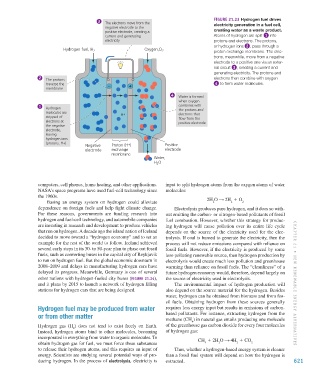Page 622 - Environment: The Science Behind the Stories
P. 622
3 The electrons move from the Figure 21.23 Hydrogen fuel drives
electricity generation in a fuel cell,
negative electrode to the creating water as a waste product.
positive electrode, creating a
current and generating Atoms of hydrogen are split 1 into
electricity protons and electrons. The protons,
or hydrogen ions 2 , pass through a
Hydrogen fuel, H Oxygen,O proton exchange membrane. The elec-
2
2
trons, meanwhile, move from a negative
electrode to a positive one via an exter-
nal circuit 3 , creating a current and
generating electricity. The protons and
2 The protons electrons then combine with oxygen
traverse the – + 4 to form water molecules.
membrane
4 Water is formed
when oxygen
1 Hydrogen combines with
molecules are H + the protons and
electrons that
stripped of flow from the
electrons at positive electrode
the negative
electrode,
leaving
hydrogen ions
(protons, H+)
Negative Proton (H + ) Positive
electrode exchange electrode
membrane
Water,
H 2 O
computers, cell phones, home heating, and other applications. input to split hydrogen atoms from the oxygen atoms of water
NASA’s space programs have used fuel-cell technology since molecules:
the 1960s.
Basing an energy system on hydrogen could alleviate 2H O S 2H 1 O 2
2
2
dependence on foreign fuels and help fight climate change. Electrolysis produces pure hydrogen, and it does so with-
For these reasons, governments are funding research into out emitting the carbon- or nitrogen-based pollutants of fossil
hydrogen and fuel-cell technology, and automobile companies fuel combustion. However, whether this strategy for produc-
are investing in research and development to produce vehicles ing hydrogen will cause pollution over its entire life cycle
that run on hydrogen. A decade ago the island nation of Iceland depends on the source of the electricity used for the elec-
decided to move toward a “hydrogen economy” and to set an trolysis. If coal is burned to generate the electricity, then the
example for the rest of the world to follow. Iceland achieved process will not reduce emissions compared with reliance on
several early steps in its 30- to 50-year plan to phase out fossil fossil fuels. However, if the electricity is produced by some
fuels, such as converting buses in the capital city of Reykjavik less-polluting renewable source, then hydrogen production by
to run on hydrogen fuel. But the global economic downturn in electrolysis would create much less pollution and greenhouse
2008–2009 and delays in manufacturing hydrogen cars have warming than reliance on fossil fuels. The “cleanliness” of a
delayed its progress. Meanwhile, Germany is one of several future hydrogen economy would, therefore, depend largely on
other nations with hydrogen-fueled city buses (Figure 21.24), the source of electricity used in electrolysis.
and it plans by 2015 to launch a network of hydrogen filling The environmental impact of hydrogen production will CHAPTER 21 • N E w R ENE wA bl E E NER gy AlTERN AT iv E s
stations for hydrogen cars that are being designed. also depend on the source material for the hydrogen. Besides
water, hydrogen can be obtained from biomass and from fos-
sil fuels. Obtaining hydrogen from these sources generally
Hydrogen fuel may be produced from water requires less energy input but results in emissions of carbon-
or from other matter based pollutants. For instance, extracting hydrogen from the
methane (CH ) in natural gas entails producing one molecule
4
Hydrogen gas (H ) does not tend to exist freely on Earth. of the greenhouse gas carbon dioxide for every four molecules
2
Instead, hydrogen atoms bind to other molecules, becoming of hydrogen gas:
incorporated in everything from water to organic molecules. To CH 1 2H O S 4H 1 CO
obtain hydrogen gas for fuel, we must force these substances 4 2 2 2
to release their hydrogen atoms, and this requires an input of Thus, whether a hydrogen-based energy system is cleaner
energy. Scientists are studying several potential ways of pro- than a fossil fuel system will depend on how the hydrogen is
ducing hydrogen. In the process of electrolysis, electricity is extracted. 621
M21_WITH7428_05_SE_C21.indd 621 12/12/14 4:29 PM

